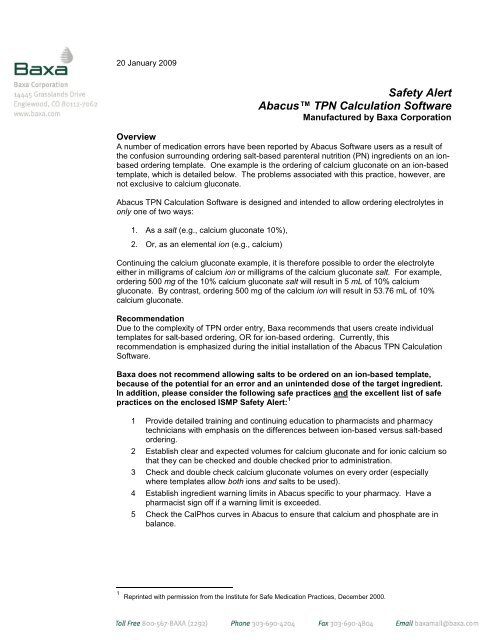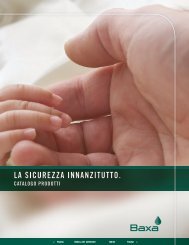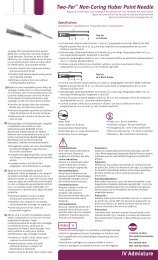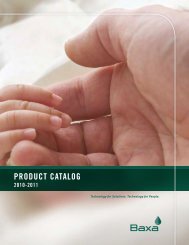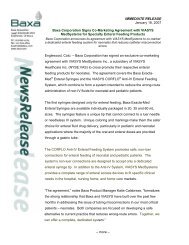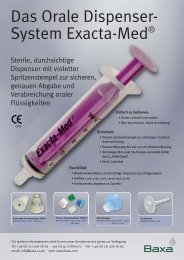Safety Alert Abacus™ TPN Calculation Software - Baxa
Safety Alert Abacus™ TPN Calculation Software - Baxa
Safety Alert Abacus™ TPN Calculation Software - Baxa
You also want an ePaper? Increase the reach of your titles
YUMPU automatically turns print PDFs into web optimized ePapers that Google loves.
20 January 2009<br />
<strong>Safety</strong> <strong>Alert</strong><br />
Abacus <strong>TPN</strong> <strong>Calculation</strong> <strong>Software</strong><br />
Manufactured by <strong>Baxa</strong> Corporation<br />
Overview<br />
A number of medication errors have been reported by Abacus <strong>Software</strong> users as a result of<br />
the confusion surrounding ordering salt-based parenteral nutrition (PN) ingredients on an ionbased<br />
ordering template. One example is the ordering of calcium gluconate on an ion-based<br />
template, which is detailed below. The problems associated with this practice, however, are<br />
not exclusive to calcium gluconate.<br />
Abacus <strong>TPN</strong> <strong>Calculation</strong> <strong>Software</strong> is designed and intended to allow ordering electrolytes in<br />
only one of two ways:<br />
1. As a salt (e.g., calcium gluconate 10%),<br />
2. Or, as an elemental ion (e.g., calcium)<br />
Continuing the calcium gluconate example, it is therefore possible to order the electrolyte<br />
either in milligrams of calcium ion or milligrams of the calcium gluconate salt. For example,<br />
ordering 500 mg of the 10% calcium gluconate salt will result in 5 mL of 10% calcium<br />
gluconate. By contrast, ordering 500 mg of the calcium ion will result in 53.76 mL of 10%<br />
calcium gluconate.<br />
Recommendation<br />
Due to the complexity of <strong>TPN</strong> order entry, <strong>Baxa</strong> recommends that users create individual<br />
templates for salt-based ordering, OR for ion-based ordering. Currently, this<br />
recommendation is emphasized during the initial installation of the Abacus <strong>TPN</strong> <strong>Calculation</strong><br />
<strong>Software</strong>.<br />
<strong>Baxa</strong> does not recommend allowing salts to be ordered on an ion-based template,<br />
because of the potential for an error and an unintended dose of the target ingredient.<br />
In addition, please consider the following safe practices and the excellent list of safe<br />
practices on the enclosed ISMP <strong>Safety</strong> <strong>Alert</strong>: 1<br />
1 Provide detailed training and continuing education to pharmacists and pharmacy<br />
technicians with emphasis on the differences between ion-based versus salt-based<br />
ordering.<br />
2 Establish clear and expected volumes for calcium gluconate and for ionic calcium so<br />
that they can be checked and double checked prior to administration.<br />
3 Check and double check calcium gluconate volumes on every order (especially<br />
where templates allow both ions and salts to be used).<br />
4 Establish ingredient warning limits in Abacus specific to your pharmacy. Have a<br />
pharmacist sign off if a warning limit is exceeded.<br />
5 Check the CalPhos curves in Abacus to ensure that calcium and phosphate are in<br />
balance.<br />
1 Reprinted with permission from the Institute for Safe Medication Practices, December 2000.
Reference 2<br />
Page 2 of 4<br />
Ordering Ions by Weight<br />
The Abacus <strong>Software</strong> has inherent knowledge of ion properties, and it uses this knowledge to<br />
translate the molar concentration to the equivalent gram weight of the ion that is delivered by<br />
a salt. Using calcium gluconate 10% as an example, if the user requests that 100 mg of the<br />
product be delivered, Abacus will multiply the 0.465 mEq/mL times the molecular weight of<br />
calcium divided by its valence to arrive at the milligrams of ELEMENTAL calcium that will be<br />
delivered per mL.<br />
0.465 mEq/mL x 40.08 mg/mMol / 2 (valence) = 9.3 mg of Ca++/mL<br />
Note: This is not the number of milligrams of SALT per mL of solution.<br />
Users cannot order the amount of a salt in an ion-based formula, because the software will<br />
convert the millequivalent concentration to the amount of the elemental ion. Therefore, if 100<br />
mg/kg of calcium is ordered in the above example, the software will calculate the dose to be<br />
10.75 mL of calcium gluconate solution per kilogram of body weight.<br />
2 Abacus Operator Manual, page 137<br />
Identification of Risk<br />
To check your facility’s ordering practices, review the <strong>TPN</strong> order forms. If all electrolytes<br />
(e.g., chloride, potassium, acetate, sodium, etc.) are listed as ions except calcium, which may<br />
be listed as calcium gluconate, the Abacus software may be configured to allow the ordering<br />
of salts on an ion-based template. Below is an example of this type of <strong>TPN</strong> order form:<br />
Ordered<br />
Normal<br />
Drug Amount Unit Requirements<br />
Sodium mEq/Kg 2 – 8 mEq/Kg<br />
Potassium mEq/Kg 1.5 – 6 mEq/Kg<br />
Calcium Gluconate mg/Kg 100 – 500 mg/Kg<br />
Chloride mEq/Kg 1 – 4.5 mEq/Kg<br />
Phosphate mM/Kg 1 – 3 mM/Kg<br />
Magnesium mEq/Kg 0.25 – 1 mEq/Kg<br />
NOTE: One possible indicator that a template allows a combination of salt- and ion-based<br />
ordering is that ion-based ordering is in milliequivalents and millimoles of the ion while saltbased<br />
ordering is in milligrams of salt. In the above example, calcium gluconate is ordered in<br />
milligrams/kg.<br />
If you suspect that your facility is using an ordering practice that is not recommended, check<br />
your Abacus Formulary Ingredient Detail. The Abacus Administrator can determine this<br />
software configuration by performing the following steps:<br />
1. Log in to Abacus.<br />
2. Access the “File � Formulary…” menu item.<br />
3. Click on the calcium gluconate formulary item (for ion-based ordering it should look<br />
similar to the screen shot on page 3).<br />
a. Abacus uses the values in the attribute fields to perform ion balancing calculations.<br />
b. For either ion-based or salt-based ordering, the Ion Attribute Value must be entered<br />
correctly for all electrolytes.<br />
c. In either ordering method, the Ion Attribute Value must be equal to the amount of<br />
elemental calcium (or magnesium, potassium, etc.) contained in the source<br />
ingredient.
Drug Concentration<br />
must be correctly<br />
entered here �<br />
Page 3 of 4<br />
i. For the most common commercially available calcium gluconate the<br />
value to be entered in the attribute value field is one of the following:<br />
1. 0.465 mEq/mL<br />
2. 9.3 mg/mL<br />
ii. The value entered here should NOT be the concentration of salt<br />
contained in the calcium gluconate (i.e., it should not equal 100mg/mL).<br />
Warning: These values may be different for the electrolyte in use at your facility. To<br />
ensure safe practice, review and use the values provided by the drug manufacturer.<br />
Ion Attribute<br />
Value must be<br />
correctly entered<br />
� here<br />
d. In either ordering method, the value for drug concentration in Abacus may be<br />
practice-specific.<br />
i. Abacus uses values in the concentration field to calculate based on<br />
ingredient concentration and unit of measure.<br />
ii. If your facility orders calcium gluconate by milligrams then the ingredient<br />
concentration must be equal to the manufacturer’s value for calcium<br />
gluconate in milligrams per milliliter (e.g. approximately 100 mg/mL).<br />
iii. If your facility orders calcium gluconate by milli-equivalents then the<br />
ingredient concentration must be equal to the manufacturer’s value for<br />
calcium gluconate in milli-equivalents per milliliter (e.g. 0.465 mEq/mL)<br />
Conclusion<br />
It is easier than you may think to commit a dosing error, as reported incidents have<br />
shown and the enclosed example demonstrates. This ISMP <strong>Safety</strong> <strong>Alert</strong> shows one example<br />
of how ordering “calcium as gluconate” on an ion-based order can lead to a serious dosing<br />
error (i.e., a tenfold or greater overdose).<br />
This <strong>Safety</strong> <strong>Alert</strong> is intended as a reminder to you regarding the potential for these serious<br />
types of errors, and to provide a recommendation for the best practice in safe compounding.
Page 4 of 4<br />
If your Abacus <strong>TPN</strong> <strong>Calculation</strong> <strong>Software</strong> has been set up to allow the ordering of salts on an<br />
ion-based template, please contact <strong>Baxa</strong> Technical Support (800-678-2292). Technical<br />
Support for the Abacus <strong>TPN</strong> Calculating <strong>Software</strong> is available 24 hours a day, 7 days a week.<br />
As always, contact Technical Support if you have any questions or require further assistance<br />
with your <strong>Baxa</strong> hardware and software products.<br />
Sincerely,<br />
Patrick Hynes<br />
VP Global Quality<br />
<strong>Baxa</strong> Corporation<br />
303-617-2121 Office<br />
pat.hynes@baxa.com
<strong>Baxa</strong> Corporation Setup Verification Form<br />
Please provide feedback on your current calcium and magnesium configurations to allow <strong>Baxa</strong> Technical Support<br />
to determine and address any issues with your setup. Perform the steps below, complete this form and return it<br />
to <strong>Baxa</strong> as soon as possible.<br />
To do this, open your formulary using the instructions below and log the concentration and attribute value for each<br />
calcium and magnesium ingredient. A screen shot of the formulary appears below.<br />
1. Go to File � Formulary.<br />
2. Single click on the first calcium ingredient.<br />
3. Complete the information on the table below for the ingredient, and repeat for all instances of calcium and<br />
magnesium in your formulary.<br />
Ingredient Name Concentration Attribute Value<br />
e.g., Calcium Gluconate 0.465 mEq/mL 0.465 mEq/mL<br />
Your signature below acknowledges your receipt and understanding of this <strong>Safety</strong> <strong>Alert</strong>. It is your responsibility to<br />
communicate this information to other users of the <strong>Baxa</strong> Abacus <strong>Software</strong>.<br />
Printed Name Signature<br />
Title/Date Facility Name<br />
City/State Zip/Postal Code<br />
Thank you for providing this information, which will help us update your system, if necessary. Return this form to<br />
<strong>Baxa</strong> Corporation by fax attn: Anne Szilagy (303.690.4804), email (quality@baxa.com) or in the enclosed<br />
business reply envelope.
ART IMITATES LIFE! ERROR PORTRAYAL REALLY HAPPENED<br />
From the December 13, 2000 issue<br />
PROBLEM: The opening general session at the recent ASHP Midyear Clinical Meeting in Las Vegas featured a<br />
dramatic production that focused on a medication error and its wide-ranging effects on the patient, his family, and<br />
the involved healthcare professionals. In "Anatomy of an Error," a pediatric patient received an overdose of IV<br />
calcium gluconate. The drug was ordered as "calcium gluconate 1,200 mg." However, a seasoned pharmacist<br />
prepared 1,200 mg of elemental calcium (nearly 130 mL using 10% calcium gluconate injection). Some in the ASHP<br />
audience probably wondered how anyone could overlook such a large dose of calcium for a pediatric patient.<br />
Coincidentally, just a few days prior to the meeting, an actual medication error report reached us that closely<br />
resembled the dramatic presentation. In the actual incident, a 2-day-old infant with a serum calcium of 6.7 was<br />
ordered "calcium gluconate 400 mg IV." Package labeling on the vial is a set-up for confusion. One label we recently<br />
examined stated "0.465 mEq Ca ++ /mL" in bold print on the front of the label but also stated, "each mL contains<br />
calcium gluconate 94 mg" in the fine print on the back. The label further mentioned "9.3 mg Ca ++ /mL" in bold in<br />
another spot on the label. The nurse confused this statement about the mg amount of elemental calcium with the<br />
mg amount of the salt, calcium gluconate. For the 400 mg dose of calcium gluconate that was ordered, she divided<br />
it by 9.3 and calculated that she needed 43 mL. A 50 mL vial of calcium gluconate (approximately 1 g/10 mL) was<br />
removed from a crash cart and 43 mL (approximately 4 g of calcium gluconate or 20 mEq of calcium ion) was<br />
administered to the infant instead of around 4 mL or 400 mg. There was an immediate deterioration of the infant's<br />
condition, but fortunately, as in the ASHP drama, the infant survived the error.<br />
It is easier than you may think for staff to become confused by product labeling. Variations in the way prescribers<br />
express the dose of calcium gluconate can also lead to dosing errors. Some prescribe the drug as mg of elemental<br />
calcium while others express the dose in mEq of elemental calcium. Still others prescribe the drug in terms of<br />
calcium gluconate and others in terms of volume and percent concentration (e.g., 10 mL of a 10% solution). The<br />
lack of a standardized method for expressing doses of calcium gluconate (and calcium chloride), and the lack of a<br />
standard dose expression in labeling, increases potential for serious medication errors.<br />
SAFE PRACTICE RECOMMENDATION: The dosage of parenteral calcium should be standardized at each practice<br />
site and based on the amount of elemental calcium rather than the mg strength of the salt. Develop protocols for<br />
the use of electrolyte solutions, including calcium gluconate, to address proper dose expression in mEq of elemental<br />
calcium, dose limits, labeling methods, infusion rates, and necessary monitoring parameters. Require independent<br />
double checks of all calculations and dose preparations for concentrated electrolytes or electrolyte solutions.<br />
Minimize the vial size (no 50 mL vials) and quantity of calcium gluconate available in patient care areas, including<br />
storage in crash carts and automated dispensing cabinets. Whenever possible, have all IV infusions prepared in the<br />
pharmacy. If calcium supplements must be a part of floor stock, use auxiliary labels that clearly state the total<br />
contents of calcium (in mEq). In hospitals without 24-hour pharmacy service, a "night formulary" should be created<br />
which allows minimal amounts and volumes of medications to be available for use after hours. Specific directions for<br />
preparation of electrolyte solutions should be provided. On-call pharmacists should be contacted for any medicationrelated<br />
questions. Each morning, pharmacy staff should immediately reconcile all drugs removed from the night<br />
cabinet via comparison against the physician's orders. Educate the staff about the proper dosing of calcium during<br />
orientation and through continuing education.<br />
© 2009 Institute for Safe Medication Practices. All rights reserved


